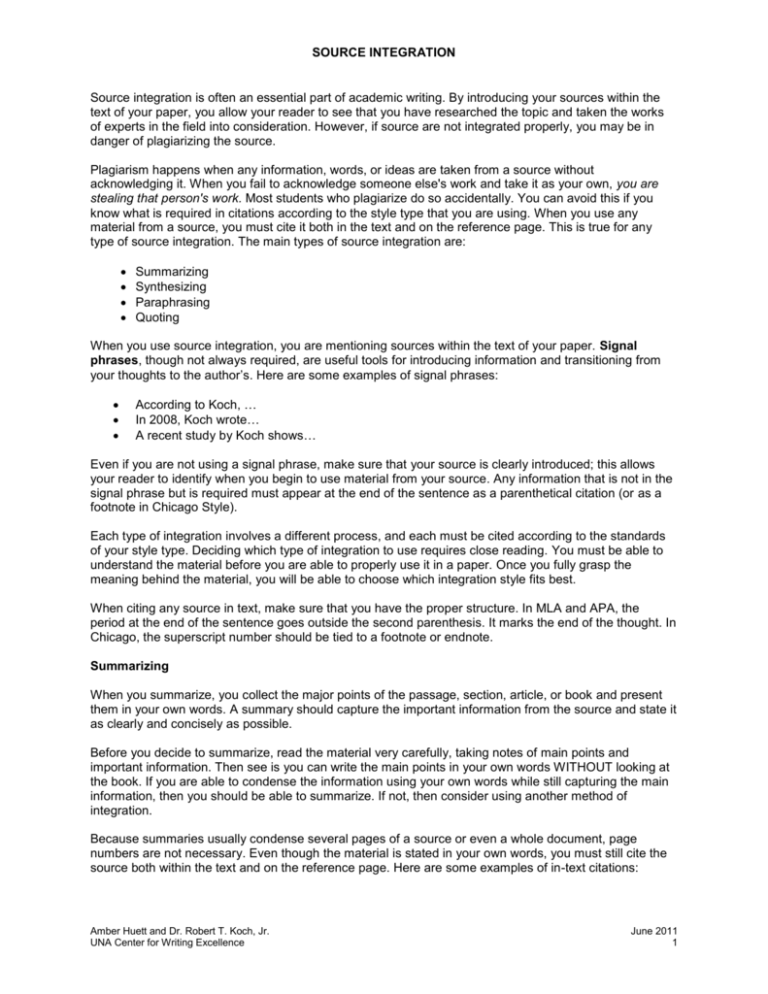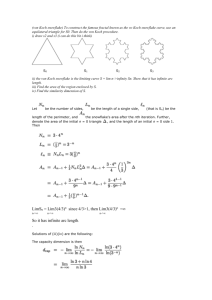SOURCE INTEGRATION Source integration is often an essential
advertisement

SOURCE INTEGRATION Source integration is often an essential part of academic writing. By introducing your sources within the text of your paper, you allow your reader to see that you have researched the topic and taken the works of experts in the field into consideration. However, if source are not integrated properly, you may be in danger of plagiarizing the source. Plagiarism happens when any information, words, or ideas are taken from a source without acknowledging it. When you fail to acknowledge someone else's work and take it as your own, you are stealing that person's work. Most students who plagiarize do so accidentally. You can avoid this if you know what is required in citations according to the style type that you are using. When you use any material from a source, you must cite it both in the text and on the reference page. This is true for any type of source integration. The main types of source integration are: Summarizing Synthesizing Paraphrasing Quoting When you use source integration, you are mentioning sources within the text of your paper. Signal phrases, though not always required, are useful tools for introducing information and transitioning from your thoughts to the author’s. Here are some examples of signal phrases: According to Koch, … In 2008, Koch wrote… A recent study by Koch shows… Even if you are not using a signal phrase, make sure that your source is clearly introduced; this allows your reader to identify when you begin to use material from your source. Any information that is not in the signal phrase but is required must appear at the end of the sentence as a parenthetical citation (or as a footnote in Chicago Style). Each type of integration involves a different process, and each must be cited according to the standards of your style type. Deciding which type of integration to use requires close reading. You must be able to understand the material before you are able to properly use it in a paper. Once you fully grasp the meaning behind the material, you will be able to choose which integration style fits best. When citing any source in text, make sure that you have the proper structure. In MLA and APA, the period at the end of the sentence goes outside the second parenthesis. It marks the end of the thought. In Chicago, the superscript number should be tied to a footnote or endnote. Summarizing When you summarize, you collect the major points of the passage, section, article, or book and present them in your own words. A summary should capture the important information from the source and state it as clearly and concisely as possible. Before you decide to summarize, read the material very carefully, taking notes of main points and important information. Then see is you can write the main points in your own words WITHOUT looking at the book. If you are able to condense the information using your own words while still capturing the main information, then you should be able to summarize. If not, then consider using another method of integration. Because summaries usually condense several pages of a source or even a whole document, page numbers are not necessary. Even though the material is stated in your own words, you must still cite the source both within the text and on the reference page. Here are some examples of in-text citations: Amber Huett and Dr. Robert T. Koch, Jr. UNA Center for Writing Excellence June 2011 1 SOURCE INTEGRATION MLA: Koch argues that... Research shows that... (Koch). APA: Koch (2008) argues that... Data shows that... (Koch 2008). Chicago/Turabian (note): 3 A study in 2008 shows that... 7 The literature argues... Synthesis Synthesis is a form of summarizing that combines several sources. To synthesize, you should combine summaries from sources that agree on many overall points. Make sure that ALL points of agreement appear in ALL texts. It is unacceptable to misrepresent a source simply to make it fit into your paper. Like summaries, synthesized sources do not require page numbers because the summary represents more than one source. Here are some examples of in-text citations for synthesized sources: MLA: Studies by Koch, Green, and Coates agree that… Studies show that… (Koch; Green; Coates). APA: Studies (Coates, 2007; Green, 2010; Koch, 2008) agree that… Data has shown that (Coates, 2007; Green, 2010; Koch, 2008). Chicago/Turabian (note): Some sources have claimed…² Note: For Chicago style formatting, multiple citations should be listed in the same footnote in order to group all sources together. Paraphrasing Paraphrases are similar to summaries in that they use your own words; however, paraphrases focus on a small part of text while summaries focus on a larger portion. When you read a source, you may not be able to condense the material while still capturing the important information. When this happens, you may need to paraphrase an important passage by restating the information in your own words. Unlike summaries, paraphrases CANNOT be synthesized and must include page numbers. Paraphrases should basically state the same thing as the original source using your own words. Remember, you must not misrepresent a source. Here are some examples of in-text citations for paraphrased text: MLA: According to Koch... (42). The data represents... (Koch 42). APA: Koch (2008) states that... (p. 42). The literature represents... (Koch, 2008, p. 42). Chicago/Turburabian (note): 7 According to Koch,... 3 History has shown that... Amber Huett and Dr. Robert T. Koch, Jr. UNA Center for Writing Excellence June 2011 2 SOURCE INTEGRATION When citing with quotes or paraphrases, remember that APA style requires a “p.” before the page number whereas MLA does not. Quoting Quoting sources is perfectly acceptable in papers; however, your paper should not be filled with quotations. Most professors would prefer that you use one of the other methods of source integration. They would rather hear you express your point in your own words. Quotations should only be used when you are planning on analyzing the text or when you cannot put it into your own words. In the latter case, the quotation is too precise to be phrased any other way. All quotations must appear in your paper EXACTLY as they do in the original source. DO NOT misrepresent a source with any quotations that are taken out of context or that do not reflect the overall meaning of the paper. Using quotes does not make up for a lack of knowledge of the subject matter. If you use a quote, you should be able explain the meaning and discuss the significance. If necessary, use a dictionary to figure out the meaning of the quotation. If you have the wrong meaning and use it in a way that contradicts your paper or is irrelevant, you will only discredit yourself. Like paraphrases, quotations cannot be synthesized. This is because the words are exact from one particular source. You should provide page numbers for quotations whenever possible. Page numbers allow your reader to find the quotation and read the surrounding material. Signal phrases for quotations are important. Technically, you can save all of your citation for the end of the sentence, but this does not make for a good paper. Using a quotation without any sort of introduction or signal makes it sound abrupt and out of place. Here are some examples of in-text citations for quotations: MLA: According to Koch, "..." (42). "..." (Koch 42). APA: Koch (2008) says, "..." (p. 42). "..." (Koch, 2008, p. 42). Chicago/Turabian (note): 7 According to Koch, "..." 3 "..." See your handbook, style guide, a credible web resource, or the writing center for more information. Sources Consulted*: American Psychological Association. (2001). Publication manual of the American Psychological Association (5th ed.). Washington D.C.: American Psychological Association. Modern Language Association of America. MLA Handbook for Writers of Research Papers. 7th ed. New York: MLA Association of America, 2009. Print Turabian, Kate. A Manual for Writers of Research Papers, Theses, and Dissertations. 7th ed. Chicago: University of Chicago Press, 2007. * Note: All sources are cited according to their own citation style. Amber Huett and Dr. Robert T. Koch, Jr. UNA Center for Writing Excellence June 2011 3








